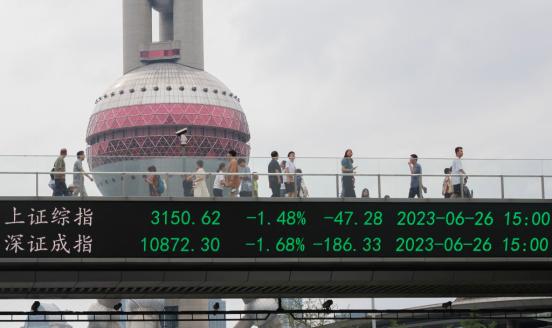South Korea's rollercoaster relations with China offer lessons for Europe

If I had to pinpoint a country whose economic relationship with China could be relevant for the European Union, it would be South Korea.
South Korea has long engaged in substantial trade with China, larger than the EU’s, in relative terms. Within the EU, Germany stands out as a country with a rather similar economic structure to South Korea. It is that similarity that allows for some relevant lessons to be drawn out.
Both South Korea and Germany benefitted from China becoming a manufacturing power, which has created a huge demand for machinery, chemicals, auto parts, and other industrial inputs. In South Korea’s case, semiconductors became the most important export, given China’s appetite for chips, which rank first in China’s import basket, even before oil.
Compared to Germany, South Korea has gone much further in its trade relations with China; already in 2003 China was its largest trading partner. Germany’s participation in the European single market obscured China’s attractiveness as a market for German exports, while South Korea went all-in. As a result, China’s imports of goods from South Korea reached $160 billion in 2018 (26% of South Korea’s total exports), while imports from China remained at $107 billion (21% of South Korea’s imports). The resulting large trade surplus for South Korea was as welcome as it was exceptional, compared to other major economies. Only Taiwan has an even larger bilateral trade surplus with mainland China and for the same reason: China’s insatiable demand for chips.
The level of commitment between China and South Korea is also reflected in their trade agreements. In 2015, they signed a bilateral free-trade agreement and in November 2020, along with 13 other Asia-Pacific nations, they signed the Regional Comprehensive Economic Partnership, the first free-trade agreement among the largest economies in Asia. The EU has erred on the side of caution, opting for a more targeted negotiation on a bilateral investment agreement, the so-called Comprehensive Agreement on Investment (CAI), signed in 2020 but not ratified.
Despite South Korea’s big bet on China’s market, the relationship has not always been smooth. It deteriorated when South Korea announced in 2016 its intentions to deploy an American anti-ballistic missile defence system (Terminal High Altitude Area Defence or THAAD), a move that China strongly opposed and which led to its unofficial boycott of South Korea, by restricting imports of products (especially cosmetics), banning Chinese tour groups from South Korea and even cancelling K-pop concerts. An important lesson for Europe is how South Korea managed to end the year-long retaliation while still keeping THAAD on its soil. The strategy was basically that of de-risking, well before the president of the European Commission, Ursula von der Leyen, coined that concept in her speech in March 2023. South Korea decided to reduce its exposure to China by diversifying through nearshoring and to a smaller extent onshoring. Two sectors were key to this de-risking operation: retail and semiconductors. South Korea’s largest chain of department stores, the Lotte group, with a significant presence in mainland China, saw most of its stores in China subjected to regulatory suspensions, resulting in plummeting sales. Relations between South Korea and China normalised in late 2017, but even so, Lotte decided to leave China in 2018. With that, China lost an important source of leverage. Lotte expanded in Southeast Asia, the region that has proved to be more resilient than China in terms of consumption, especially since the pandemic started.
In 2023, two major changes took place in South Korea’s trade relationship with China. First, South Korea’s long-standing trade surplus with China turned into a large deficit as exports fell by 20%, partly due to South Korea falling under the US export ban on advanced semiconductors to China and partly due to its excess capacity for legacy semiconductors, a market niche in which China has increased its presence. Second, the US became South Korea’s most important trading partner; major conglomerates including Samsung, Hyundai Motor and even Lotte, have continued to increase investments in the US.
If we compare those trade developments with Germany, there is an apparent similarity: the sudden increase in the bilateral trade deficit (in Germany’s case in 2022) after a previously balanced position. South Korean imports from China fell by 8% with very limited imports of green tech and plans to step up barriers for environmental reasons (non-recyclable lithium in Chinese batteries for example). Germany, on the other hand, has massively increased imports from China since 2021 with its doors still open to Chinese green tech, from solar panels to, more recently, electric vehicles.
All in all, South Korea’s economic relationship with China offers lessons for Europe. First, a very complementary relationship can easily turn into one of competition and rivalry. Second, Chinese retaliation can be addressed through de-risking, defined as diversification through a combination of reshoring and nearshoring, but also by becoming indispensable in certain technologies. Finally, South Korea shows that leadership is needed to guide companies in the right direction.
ZhōngHuá Mundus is a newsletter by Bruegel, bringing you monthly analysis of China in the world, as seen from Europe.
This is an output of China Horizons, Bruegel's contribution in the project Dealing with a resurgent China (DWARC). This project has received funding from the European Union’s HORIZON Research and Innovation Actions under grant agreement No. 101061700.




